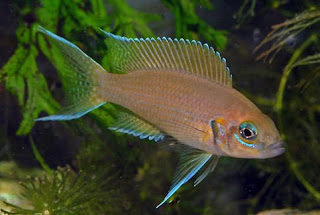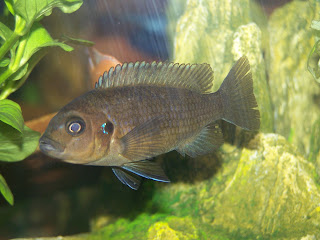Kingdom: Animalia
Phylum: Chordata
Class: Osteichthys
Order: Perciformes
Family: Cichlidae
TRIBES
The following is an outline of the tribes found in the Family Cichlidae of Lake Tanganyika:
Bathybatini - Large elongate deep-bodied cichlids built for speed. Ground color is usually silver with varuious dark blue stripes and/or spots. They are exclusively picsivicorous (fish-eating) open-water dwellers. They range in size from 10-18 inches. All species are mouthbrooding. The eggs are the largest for the family Cichlidae, approximately 1/3 inch in diameter. Species include:
- Genus: Bathybates; Species: fasciatus, ferox, graueri, horni, leo, minor, vittati
- Genus: Hermibates; Species: stenosoma
Cyprichromini - Small elongate mouthbrooding cichlids with highly protrusible mouthes for extracting plankton from the water. Body color is brownish with bright yellow, blue or black markings on the fins. These species form huge schools, often of several thousand above rocky dropoffs. They have a tendency to swim with their head tilted downward, and often completely upside-down. They range in size from 4-6 inches. Species include:
- Genus: Cyprichromis; Species: leptosoma, microlepidotus
- Genus: Cyprichromis pavo
- Genus: Paracyprichromis; Species: brieni, nigripinnis
Ectodini - Small to moderate sized (3-10 inches) mouthbrooding cichlids. Silver ground color with varying black or iridescent spots or streaks on the body and fins. Males may have brilliant metallic coloration and the fins may have filamentous extensions. They inhabit the coastline of the lake. Genera include:
- Genus: Asprotilapia; Species: leptura
- Genus: Aulonocranus; Species: dewindti
- Genus: Callochromisa; Species: macrops, melanostigma, pleurospilus, stappersii
- Genus: Cardiopharynx; Species: schoutedeni
- Genus: Cunningtonia; Species: longiventralis
- Genus: Cyathopharynx; Species: furcifer
- Genus: Ectodus; Species: descampsi
- Genus: Enantiopus; Species: melanogenys
- Genus: Grammatotria; Species: lemairii
- Genus: Lestradea; Species: persipicax, stappersii
- Genus: Microdontochromis; Species: rotundiventralis, tenuidentatis
- Genus: Ophthalmotilapia; Species: boops, heterodontus, nasutus, ventralis
- Genus: Xenotilapia; Species: bathyphilus, boulengeri, burtoni, caudafasciata, flavipinnis, longispinis, nasus, nigrolabiata, ochrogenys, ornatipinnis, papilio, sima, spilopterus
Eretmodini - Small stocky mouthbrooding cichlids with small swim bladders, and therefore inhabit the upper 6 feet of the lake. They tend to hug the bottom, and seems to hop around rather than swim.They have a underslung mouth with thick lips. Body may be vertically banded or spotted blue on the upper half. Adult size is 4 inches. Genera and species include:
- Genus: Eretmodus; Species: cyanostictus
- Genus: Spathodus; Species: erythrodon, marlieri
- Genus: Tanganicodus; Species: irsacae
Haplochomini - Stocky large-headed mouthbrooding cichlids with a pointed snout. Light beige to brown ground color with vertical barring or spots. They are predatory and often referred to as utaka. Adult size is 6-8 inches. There are two species found in lake Tanganyika. They are:
- Genus: Ctenochromis; Species: benthicola, horei
Lamprologini - A highly recognizable, variable and extensive cichlid group. The body tends to be quite elongated. Coloration can be brown, yellow, blue or black, or any combination. A thin blue trim occasionally seen on unpaired fins and around the eye. Eggs are remarkably small, and all species practice substrate spawning. The Genera include:
- Genus: Altolamprologus; Species: compressiceps, calvus
- Genus: Chalinochromis; Species: brichardi, popelini
- Genus: Julidocromis; Species: ornatus, regani, marlieri, transcriptus, dickfeldi
- Genus: Lamprologus; Species: callipterus, finalimus, kungweensis, laparogramma, lemairii, meleagris, ocellatus, ornatipinnis, signatus, speciosus, stappersi
- Genus: Lempidiolamprologus; Species: elongatus, cunningtoni, attenuatus, profundicola, kendalli, nkambae
- Genus: Neolamprologus; Species: bifasciatus, boulengeri, brevis, brichardi (now pulcher), buescheri, calliurus, caudopunctatus, christyi, crassus, cylindricus, falcicula, fasciatus, furcifer, gracilis, hecqui, helianthus, leleupi, leloupi, longicaudata, longior, marunguensis, meeli, modestus, mondabu, moorii, multifasciatus, mustax, niger, nigriventris, obscurus, olivaceous, pectoralis, petricola, pleuromaculatus, prochilus, pulcher (previously brichardi), savoryi, schreyeni, sexfasciatus, similus, splendens, tetracanthus, toae, tretocephalus, variostigma, ventralis, wauthioni,
- Genus: Telmatochromis; Species: temporalis, vittatus, dhonti, bifrenatus, burgeoni, brichardi
Limnochromini - Heavy-bodied moputhbrooding cichlids. Black spot is present on upper outer edge of the gill cover. Ground color is a mother-of-pearl sheen with incandescent stripes or spots. Adult size ranges from 4-10 inches. They inhabit the sandy muddy areas in deeper water. The Genera include:
- Genus: Baileychromis centropomoides
- Genus: Benthochromis; Species: melanoides, tricoti
- Genus: Gnathochromis; Species: permaxillaris, pfefferi
- Genus: Greenwoodochromis; Species: bellcrossi, christyi
- Genus: Limnochromis; Species: abeelei, auritus, staneri
- Genus: Reganochromis calliurus
- Genus: Tangachromis dhanisi
- Genus: Triglachromis otostigma
Perissodini - Mouthbrooding cichlids. Body is usually elongate, silvery to beige ground color overlaid with with several iridescent bluish spots. Some vertical bars may be see on some species. Diet is scales of other fish, with one exception, H. microlepis. Inhabits all depths from inshore to offshore. Adult size range is 4-13 inches. Genera include:
- Genus: Haplotaxodon microlepsis
- Genus: Perissodus; Species: eccentricus, microlepsis
- Genus: Plecodus; Species: elaviae, multidentatus, paradoxus, straeleni
Genus: Xenochromis hecqui
Tilapiini - A deep-bodied large substrate spawning cichlid found throughout the lake. Adult size range is 16-36 inches. The two species are:
- Genus: Boulengerochromis microlepsis
- Genus: Neotilapia tanganicae
Trematocarini - Small slender-bodied mouthbrooding cichlids with a silvery ground color and subtle black banding on the body and fins. Unpaired fins tend to be large and eyes are large. They are a deep water schooling fish , that migrate to the surface at night to feed on plankton. They are a fragile, light, shy cichlid.Adult size range from 3-6 inches. The Genera include:
- Genus: Telotrematocara macrostomata
- Genus: Trematocara; Species: caparti, kufferathi, marginatum, stigmaticum, unimaculatum, variabile, zebra
- Genus: Trematochromis schreyeni
Tropheini - Heavy bodied mouthbrooders that are beige to brown overlaid with darker vertical stripes. Lighter stripes or blotches may show bright colors. Most of these cichlids are found in the shallow rocky areas of the lake. Anal fin spots are present on the majority of the species.Adult size ranges from 3-16 inches.
- Genus: Cyphotilapia frontosa
- Genus: Interochromis loocki
- Genus: Limnotilapia dardennii
- Genus: Lobochilotes labiatus
- Genus: Petrochromis; Species: ephippium, famula, fasciolatus, macrognathus, orthognathus, polyodon, trewavasae
- Genus: Pseudosimochromis curvifrons
- Genus: Simochromis; Species: babaulti, diagramma, margaretae, marginatus, pleurospilus
- Genus: Tropheus; Species: brichardi, duboisi, kasabae, moorii, polli
Tylochromini - A large mouthbrooder reaching a length of 14 inches. Very deep laterally compressed body. Adults sport a small red patch at the lower cheek. Inhabits the shallow sandy areas and river mouths. Only one species:
- Genus: Tylochromis polylepis
Coming Soon: Gallery of Lake Tanganyika Cichlids


















